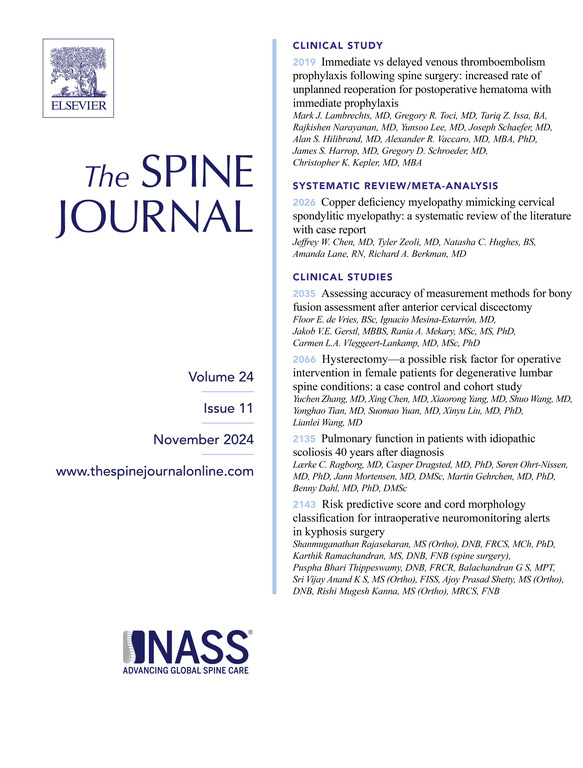Who gets better after surgery for degenerative cervical myelopathy? A responder analysis from the multicenter Canadian Spine Outcomes and Research Network
IF 4.9
1区 医学
Q1 CLINICAL NEUROLOGY
引用次数: 0
Abstract
BACKGROUND CONTEXT
Degenerative cervical myelopathy (DCM) is the most common cause of acquired nontraumatic spinal cord injury worldwide. Surgery is a common treatment for DCM; however, outcomes often vary across patients.
PURPOSE
To inform preoperative education and counseling, we performed a responder analysis to identify factors associated with treatment response.
STUDY DESIGN/SETTING
An observational cohort study was conducted utilizing prospectively collected data from the Canadian Spine Outcomes Research Network (CSORN) registry collected between 2015–2022.
PATIENT SAMPLE
We included all surgically treated DCM patients with complete 12-month follow-up and patient-reported outcomes (PROs) available at 1-year.
OUTCOME MEASURES
Treatment response was measured using the minimal clinically important difference (MCID) in PROs including the Neck Disability Index (NDI) and EuroQol-5D (EQ-5D) at 12 months postsurgery.
METHODS
A Least Absolute Shrinkage and Selection Operator (LASSO) machine learning model was used to identify significant associations between 14 preoperative patient factors and likelihood of treatment response measured by achievement of the MCID in NDI, and EQ-5D. Variable importance was measured using standardized coefficients. To test robustness of findings we trained a separate XGBOOST model, with variable importance measured using SHAP values.
RESULTS
Among the 554 DCM patients included, 229 (41.3%) and 330 (59.6%) patients responded to treatment by meeting or surpassing MCID thresholds for NDI and EQ-5D at 1-year, respectively. LASSO regression for likelihood of treatment response measured through NDI found the variable importance rank order to be baseline NDI (OR 1.06 per 1 point increase; 95% CI 1.04–1.07), then symptom duration (OR 0.65; 95% CI 0.44–0.97). For EQ-5D, the variable importance rank order was baseline EQ-5D (OR 0.16 per 0.1-point increase; 95% CI 0.03–0.78), living independently (OR 2.17; 95% CI 1.22–3.85), symptom duration (OR 0.62; 95% CI 0.40–0.97), then number of levels affected (OR 0.80 per additional level; 95% CI 0.67–0.96). A separate XGBoost model of treatment response measured through NDI, corroborated findings that patients with higher baseline NDI, and shorter symptom duration were more likely to respond to treatment, and additionally found older patients, and those with kyphosis on baseline upright X-ray were less likely to respond. Similarly, an XGBoost model for treatment response measured through EQ-5D corroborated findings that patients with higher baseline EQ-5D, shorter symptom duration, living independently, with fewer affected levels were more likely to respond to treatment, and additionally found older patients were less likely to respond.
CONCLUSIONS
Our findings suggest patients with shorter symptom duration, higher baseline patient NDI, lower EQ-5D, younger age, living independently, without kyphosis on preoperative X-ray, and fewer affected levels are more likely to respond to treatment. Timing of surgery with respect to patient symptoms is underscored as a crucial and modifiable patient factor associated with improved surgical outcomes in DCM.
颈椎退行性脊髓病手术后谁会好转?加拿大多中心脊柱结果与研究网络的应答者分析。
背景情况:退行性颈椎脊髓病(DCM)是全球最常见的后天性非外伤性脊髓损伤病因。手术是治疗 DCM 的常用方法;然而,不同患者的治疗效果往往不同。目的:为了给术前教育和咨询提供信息,我们进行了应答者分析,以确定与治疗应答相关的因素:研究设计/设置:我们利用 2015-2022 年间从加拿大脊柱结果研究网络(CSORN)登记处收集的前瞻性数据开展了一项观察性队列研究:我们纳入了所有接受过手术治疗的DCM患者,并进行了12个月的完整随访,患者报告的结果(PROs)可在1年后获得:治疗反应采用术后12个月时包括颈部残疾指数(NDI)和EQ-5D(EuroQol-5D)在内的PROs的最小临床重要差异(MCID)来衡量:方法:采用最小绝对收缩和选择运算器(LASSO)机器学习模型来识别14个术前患者因素与通过实现NDI和EQ-5D的MCID来衡量的治疗反应可能性之间的显著关联。变量的重要性使用标准化系数来衡量。为了检验研究结果的稳健性,我们训练了一个单独的 XGBOOST 模型,用 SHAP 值衡量变量的重要性:结果:在纳入的 554 名 DCM 患者中,分别有 229 名(41.3%)和 330 名(59.6%)患者在 1 年时达到或超过了 NDI 和 EQ-5D 的 MCID 阈值,从而对治疗做出了反应。对通过 NDI 测定的治疗反应可能性进行 LASSO 回归发现,变量重要性排名依次为基线 NDI(每增加 1 分 OR 1.06;95% CI 1.04 - 1.07),然后是症状持续时间(OR 0.65;95% CI 0.44-0.97)。对于 EQ-5D,变量重要性排序依次为基线 EQ-5D(每增加 0.1 分,OR 为 0.16;95% CI 为 0.03 - 0.78)、独立生活(OR 为 2.17;95% CI 为 1.22 - 3.85)、症状持续时间(OR 为 0.62;95% CI 为 0.40 - 0.97),然后是受影响的级别数(每增加一个级别,OR 为 0.80;95% CI 为 0.67 - 0.96)。另一个通过 NDI 衡量治疗反应的 XGBoost 模型证实了基线 NDI 较高和症状持续时间较短的患者更有可能对治疗产生反应,此外还发现年龄较大的患者和基线直立 X 光片显示脊柱后凸的患者不太可能对治疗产生反应。同样,通过 EQ-5D 测量治疗反应的 XGBoost 模型也证实了以下结论:基线 EQ-5D 较高、症状持续时间较短、独立生活、受影响程度较轻的患者更有可能对治疗做出反应,此外,我们还发现年龄较大的患者做出反应的可能性较低:我们的研究结果表明,症状持续时间较短、基线患者 NDI 较高、EQ-5D 较低、年龄较小、独立生活、术前 X 光检查无脊柱后凸且受影响程度较轻的患者更有可能对治疗产生反应。与患者症状相关的手术时机被强调为与改善 DCM 手术疗效相关的一个关键且可改变的患者因素。
本文章由计算机程序翻译,如有差异,请以英文原文为准。
求助全文
约1分钟内获得全文
求助全文
来源期刊

Spine Journal
医学-临床神经学
CiteScore
8.20
自引率
6.70%
发文量
680
审稿时长
13.1 weeks
期刊介绍:
The Spine Journal, the official journal of the North American Spine Society, is an international and multidisciplinary journal that publishes original, peer-reviewed articles on research and treatment related to the spine and spine care, including basic science and clinical investigations. It is a condition of publication that manuscripts submitted to The Spine Journal have not been published, and will not be simultaneously submitted or published elsewhere. The Spine Journal also publishes major reviews of specific topics by acknowledged authorities, technical notes, teaching editorials, and other special features, Letters to the Editor-in-Chief are encouraged.
 求助内容:
求助内容: 应助结果提醒方式:
应助结果提醒方式:


